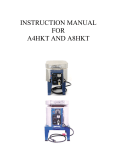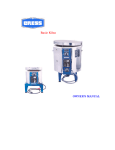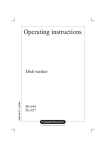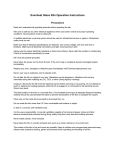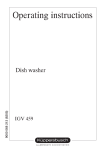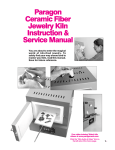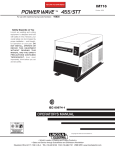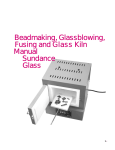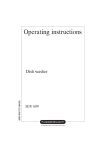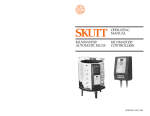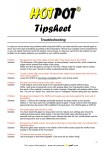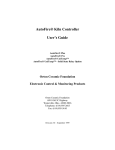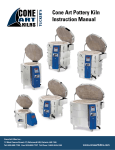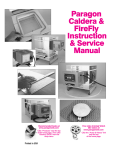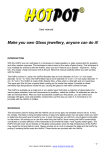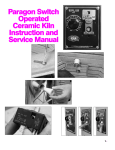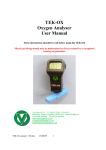Download Cress Ceramic Kiln - FXC30FH User Guide
Transcript
Cress Ceramic Kiln - FXC30FH User Guide 1 CONGRATULATIONS! Congratulations on being the owner of a CRESS ceramic kiln model FXC30FH! This kiln is a safe, reliable, and popular front loading kiln, which gives you an energy efficient firing. The kiln elements from top to bottom are adjusted electrically to give the most uniform firing possible. The use of thick firebrick plus backup insulation gives a full 6.5” multi-layer heat stopping wall that will give you the slowness in cooling that museum quality artwork requires. Cress has been at the forefront of firing processes for over 54 years (since 1946). Cress was first in our field with ultra reliable element connections, and first with infinitely variable power controls and the exclusive Firemate motorized firing control. We sincerely wish you many years of creative and rewarding use of your CRESS kiln. CRESS MANUFACTURING COMPANY, INC. 4736 Convair Dr., Carson City NV 89706 UNPACK SHIPMENT IMMEDIATELY When this shipment was given to the carrier, neither the carton nor contents were damaged. In case of damage or loss (either obvious or concealed) save all packing material. Concealed damage or loss discovered by the consignee (that was not noted at time of delivery) must be reported to the delivering carrier immediately upon discovery. At that time, an inspection of the merchandise by the carrier’s representative should be requested. Failure to report such a damage or loss within 15 days places the burden of proof upon the claimant to show this damage or loss was caused while in the carrier’s possession. Our three year limited warranty covers manufacturing defects only. Call us if a freight problem occurs so we may help. Phone (775) 884-2777 or (800) 423-4584. Instructionmanual8200fxc30fh.doc 2 INSTRUCTIONS FOR CRESS KILN MODEL FXC30FH MAXIMUM INTERMITTENT TEMP. __2400 F. NOTICE: PLEASE READ, UNDERSTAND, AND OBSERVE THE FOLLOWING INSTRUCTIONS AND SAFETY WARNINGS BEFORE OPERATING THE KILN. INSTALLATION AND KILN PLACEMENT All kilns should be located in an area free from flammable materials such as boxes, paper, spray cans, paint, gasoline, etc. This kilns must be located a minimum of 18” inches from every vertical surface, 6 feet in front of the door and 24” off to the side of the kiln opposite the door hinge. Do not place this kiln under any overhead obstruction such as cabinets, shelf, drapes, hanging plastic, etc., and never lean anything against your kiln. Do not store anything between the kiln and a wall; keep these areas clear at all times. Keep material off the top of your kiln; do not use the lid as a shelf. Care should be taken to keep the kiln away from combustible surfaces. Be sure no curtains or other material that could change position with wind or opening of a door or window can come within an unsafe distance of the kiln. Recommended floor surfaces include cement, ceramic tile with cement grout, brick, or stone. If it is necessary to put your kiln on a synthetic or wooden floor, use a sheet of fireproof material underneath your kiln and extending 36" beyond the kiln in all directions. A layer of hard firebrick is also acceptable for this purpose. Floor coloration may be sensitive to heat. Keep all flammable liquids out of the room with the kiln. Good housekeeping must be maintained at all times in the kiln area for safety. Vapors containing poisonous gases are possible when firing certain materials. A ventilation hood or other venting device is recommended. The room in which the kiln is operated should be well ventilated. Do not use the FXC30FH for a lost wax process, wax burnout or assaying since this can damage elements and present a fire safety hazard. ELECTRICAL SPECIFICATIONS Before connecting the kiln to a power source, be sure that the switches and timer are in the "off" position. Be certain that your electrical wiring, circuit breaker, and fuses are in good condition and adequate for the kiln before connecting. If you are not sure, consult a qualified, licensed electrician. Proper electrical wiring is necessary for safe and efficient operation of a kiln. Even though the voltage is a full 208 or 234 volts at the meter, the voltage on which the kiln operates will be somewhat lower at the kiln location. Make sure your electrical power has the correct electrical capacity and voltage to handle your kiln. It is necessary to measure the voltage at the location of the kiln with the kiln turned on. Voltage drops occur on all wiring. Proper electrical wiring will provide an adequate operation voltage and current at the kiln without significant voltage drop. (Voltage may be temporarily low during brownouts especially on a hot day in the summer when all your neighbors have their air conditioning turned on and during peak electrical usage periods in your area). If the wire coming from your power source to the kiln is too small or too long the kiln will not operate properly, even if the wire meets national electrical safety codes. If the voltage is low, the kiln may not reach the maximum desired temperature or will fire too slowly. Do not attempt to change the power 3 connections on an existing line without using the services of a licensed electrician. The electrician will know whether the wire size is correct. It is advisable to use a larger wire size than absolutely necessary to prevent voltage drop, especially if the run to the meter is long. The increase in cost is usually very small compared to the long-term savings in firing times and line loss (voltage loss). Temperature rating specifications (as well as the electrical rating requirements) for your kiln are listed on a decal on the kiln. Your electrician must make sure all local codes are met with your house wiring. Your licensed electrician is responsible for meeting the requirements for the local and national codes. Ground the metal case of the kiln by a separate grounding wire. Use a suitable wire gauge to handle the entire amperage possible on the incoming power line. POWER SHOULD COME FROM A FUSED DISCONNECT SWITCH IN THE IMMEDIATE VICINITY OF THIS KILN. ELECTRICAL SPECIFICATIONS*FXC30FH WIRE DIRECT SHORT RUN LONG RUN CIRCUIT VOLTS AMPS PHASE COPPER SIZE COPPER SIZE FUSE RUN<40 FEET 40’ TO 100’ SIZE 230 60 1 NO. 3 NO. 3 70 AMPS 208 75 1 NO. 2 NO. 1 90 AMPS 230 38 3 NO. 6 NO. 4 50 AMPS 208 40 3 NO. 6 NO. 4 50 AMPS • Consult with a qualified, licensed electrician for exact specifications in your local area for wire sizes. 4 IMPORTANT SAFEGUARDS! Please read and observe the following safety warnings before operating your kiln: 1. Install kiln 24" or more from any wall or combustibles – nothing obstructing front area. 2. Do not fire unattended; keep children away. 3. Never fire hotter than cone 10 or 2400 oF. 4. Do not fire hotter than the manufacturer's recommendation for your clay, glazes, or decals, or permanent damage may result to your kiln or ware. 5. Do not open door until kiln has cooled. 6. Before opening door, turn off all switches, then carefully open after cool. 7. Do not leave kiln unattended while firing. 8. Never use an extension cord. 9. Operate kiln only in a well-ventilated room preferably with a venting hood. 10. Disconnect safety power switch before servicing or cleaning. 11. Dangerous Voltage - Do not touch heating elements with anything. 12. Do not touch hot sides of kiln. Although kiln sides usually stay reasonably cool, placing anything against kiln sides can cause heat build up and a fire may result. 13. Do not use to cook food. 14. Never store anything under kiln; never lean objects against kiln. 15. Do not store or use flammable liquids or sprays in the same room with your kiln. 16. Do not store or use your kiln outside; keep rain and moisture away from kiln. 17. Do not use kiln if power wiring to kiln is damaged. 18. Use kiln only with adequate electrical supply and with the correct voltage, amperage and correct fuse size (not too large or small). Be sure the wire size is large enough (avoid aluminum wiring). Do not use a 208 VAC kiln on 220 VAC. 19. Avoid breathing fumes from materials being fired. Breathing smoke and fumes is dangerous to your health. 20. Kiln must be grounded properly. 21. Wear goggles when looking through peephole to protect your eyes from infrared heat. 22. Wear protective gloves when handling hot peephole plugs. 23. When firing objects to be used with food and drink, use only supplies tested and labeled “safe” for such purposes. 24 Use only small cones or bar cones in the Kiln Sitter – never use large cones or witness cones in the kilnsitter. 25. Maintain kiln in perfect operating order. Do not use kiln unless checked and in perfect operating condition. It is imperative that you read all instructions before operating the kiln. 5 FEATURES (Beginning at the top of the control panel) PYROMETER: This device is used for reading the temperature in the kiln. It consists of a temperature-sensing probe (the thermocouple) connected to a meter that indicates the temperature inside the kiln. Its principle value is as a monitoring aide, which displays how rapidly the kiln is heating and when desired temperature is neared. It is also very valuable when firing glass that is sensitive to differences in temperature of only a few degrees. In firing ceramic materials, the ideal situation is to fire with both Pyrometric cones and a pyrometer, since cones reveal what is happening to the ceramic in the kiln only at the final firing stage and the pyrometer shows the actual air temperature continuously through the firing. The pyrometer, however, cannot display the effects of time on the firing process, as does the cone. Do not use a pyrometer as a substitute for cones. A pyrometer measures only air temperature - and not the time/temperature relationship essential for firing ceramics. INFINTE SWITCHES: These two switches, labeled “Upper Middle” and Lower Middle” should normally be set to ‘100”. However, if the load being fired in the chamber is uneven in density, these switches can be used as an aide to adjust the percentage of power to help achieve uniform firing temperature accordingly. If the top or upper middle of the kiln is not as heavily loaded as the bottom of the kiln, you can turn down the “Upper Middle Switch” to 75 to compensate. Or, if the bottom section of the kiln was firing too hot, you could turn the “Lower Middle Switch” to a lower setting. Turn only one of the two switches down at a time to allow the kiln to have enough power to reach full temperature in a reasonable time. This is a percentage switch, which cycles the elements off and on. For example “low” =25% power (“0” dial setting), “medium”=50% power (“50” dial setting), “high”=100% (“90” to “100” on the dial setting). At “10” the on/off cycling of the elements is approximately 25% on and 75% off while at “50” the elements on/off cycling is just a little over 50%. TURN ALL SWITCHES OFF AFTER EVERY FIRING EVEN IF THE KILN SITTER APPEARS TO HAVE OPERATED PROPERLY. FIREMATE SPEED CONTROL: this control causes a motor to advance the “thumbwheel” at different speeds. It allows you to increase or decrease the rate of temperature climb in order to fire at a speed appropriate for the ware being fired. The FXC30FH is a very large and nominally slow firing kiln. The normal speed is “A” for every thing unless you desire an extra slow firing for very special work. Some handmade pieces are fired more safely at the slower firing modes (“D” or “E”). Very thick pieces, such as handmolded sculptures may require even slower heating and cooling that may be accomplished using the “”Stop” or “Manual” setting as described in the firing section. THUMBWHEEL: This is a percentage of power control that increases power to the elements. The thumbwheel works in conjunction with the Firemate Speed Control. First choose an automatic speed setting (“A” through “E”) (“A” is the fastest or normal speed to “E” that is the slowest automatic firing speed) is selected on the Speed Control. Then set the Thumbwheel to “1” to start firing. The thumbwheel will then advance the kiln power automatically. If the Speed Control is set to “Stop Manual”, the thumbwheel must be 6 advanced manually. The Thumbwheel increases power to the elements to provide a gradual temperature climb. When the Thumbwheel is at “1”- the percentage of on to off time power is applied to the elements is approximately 25% on and 75% off. At “5” it is 55% on and 45% off (usually about 8 seconds on and 7 seconds off for a 230 volt kiln. (A higher ratio for 208 volt kilns is normal at each setting to enhance performance). The thumbwheel stops advancing automatically when 100% power is achieved. 100% power is reached when the thumbwheel is at between “8” and “10” on the dial (lower on 208 volt power). The thumbwheel switch automatically compensates for lower voltage conditions by causing the power to reach 100% power at a lower setting. This nice feature allows the kiln to behave more consistently under varying power conditions. HIGH LIMIT CONTROL: This device is a backup to the Kiln sitter Limit Timer. The Kiln-Sitter is designed to be the primary shut-off device to achieve consistent firing. However, it can fail for many reasons: If the cone sticks to the cone supports (no kiln wash applied), if a ceramic piece breaks during firing and falls against the tube assemble, if the kiln sitter is not properly adjusted. The high limit control should be set for 50 degrees F above the firing temperature of the cone being used in the Kiln-Sitter. (See the Cone/Temp chart on the back of this manual or the Kiln Sitter manual or 270 F rate. If the kiln-Sitter should fail and the kiln continues to climb in temperature, the High limit control with shut down the kiln after its set temperature is reached, it is very important not to set the High Limit Control too high. Your ware could melt and the kiln could be destroyed. Also, too low a setting would cause the kiln to shut off too soon so your ware would not be properly fired. The high limit temperature control uses the temperature at the tip of the thermocouple. That is the point the two different alloy wires are welded. Therefore, this thermocouple must extend into the kiln at least 1-1/2" to obtain a correct temperature reading. You should keep in mind that contamination from products fired might alter its calibration. Change the thermocouple should you doubt the temperature control. Pyrometric cones are another inexpensive way to check the control reading. HIGH LIMIT CONTROL PILOT LIGHT AND RESET BUTTON: Light remains on during firing. Reset button is used to reset the high limit control. KILN-SITTER LIMIT TIMER (MODEL LTK): This device is located behind the control panel. The kiln-Sitter is a mechanical control that shuts off your kiln (most of the time but not always) by the time/temperature cone-melt method using a “small” cone or bar cone. When the Pyrometric cone on the Kiln-Sitter tube assembly has been exposed to the proper time at temperature, the cone softens and bends allowing the rod to drop down and the weight to drop so the mechanical relay shuts the kiln off. While the Kiln-Sitter is the primary shut off device, the 20-hour limit timer is a secondary safety backup shutoff device to protect your kiln from over-firing if the kiln sitter fails to operate. Since the function of the limit timer is to back up the actual firing, it should always be set for a slightly longer period of time than the estimated firing time. After you have become familiar with the firing of you kiln, you should set the time no more than 1/2 hour longer than the estimated firing time. 7 LOADING The insulating firebrick used in ceramic kilns is soft and fragile. Care should be taken to avoid damaging the brick kiln liner when loading and unloading the kiln. Make sure that any ware you put into your kiln is bone dry (not cold to the touch). If pieces are hand molded, make sure that no air pockets remain in the clay. Air pockets cause small “explosions” when fired when the air expands and the moisture turns to steam. Hollow out solid pieces whenever possible. Thick solid pieces can be fired safely only at very slow heating and cooling rates. Solid pieces tend to crack and break more easily during firing than hollowed pieces. Your kiln is designed to provide as uniform as heat as possible throughout the firing chamber. The kiln should be loaded in a balanced manner. Mix heavy and light pieces when firing in the same load. Light and heavy ware should be alternated on the same shelf and distributed through the kiln to help the kiln heat evenly. This will assure that all pieces receive the same heat treatment. Even though the door safety switch will turn off power to the elements when the door is opened, turn off kiln power manually before opening the door. Also avoid the possibility of shock by not touching the heating elements with your hand or with metal objects. The load should be placed as near the center of the chamber as possible to give you a uniform temperature. For those operations requiring very accurate temperatures the hearth plate should be raised on ceramic blocks to provide air circulation below the hearth plate. Also, your load must not touch the thermocouple (2 wires covered by ceramic beads at the rear of the chamber), as this will tend to give you the temperature of the load rather than the air and cause over-heating. Thermocouples should not be bent against the wall, but remain at least l-1/2" into the chamber. Loads should not be placed against the walls, elements, or kiln sitter tube assembly. Space your load as much as possible for air circulating between parts to give you even heating throughout the chamber. Post Placement: Be sure to place vertical columns of post throughout the kiln. The posts must run in a direct line vertically through the kiln to support the shelf load and prevent shelves from bending. HEATING: FIRST TIME USE: The elements are made of a very high temperature alloy wire. The chamber is rated for 2400oF; you should fire the chamber without a load to 2000oF and allow to cool slowly with the door closed. This allows the elements to achieve a good oxide coating that protects the elements on subsequent firings. The high temperature also stabilizes the wire element to seat into the element plate or groove securely. High temperature wire elements tend to grow when only fired to low temperatures (below 1600oF) and may creep out of the element plate or groove. If after low temperature firings, you notice any tendency of the elements to creep out of the plate or groove, you should again fire the chamber empty to 2000oF. This will also help heal any thin areas of protective oxide coating on the element. This process should also be repeated when new elements are installed. Do not heat the kiln to temperatures higher than necessary for your process and not for longer periods than required. The higher the temperature and the longer the time in use the shorter the element life and the thermocouple life.If the kiln is used at temperatures over 1600oF, the 8 thermocouple and the elements will eventually burn out. The thermocouple should be replaced about once a year in heavy use. The calibration of the thermocouple can be affected by contaminants fired in the kiln. We do not recommend changing heating elements until they burn out or are so worn that they slow the heating time materially. All controls, switches, and electrical components are subject to failure; therefore, you should check the kiln periodically to be sure it is heating properly. UNLOADING: Kiln may be unloaded cold. Avoid the possibility of shock by not touching the heating elements with your hand or tongs. The kiln brick may develop cracks due to the heat shock of the cold air if loaded or unloaded when hot. When opening the door "hot" you should wear protective gloves to prevent burns on hands and arms. If very hot, you should wear a face shield also. Wear welder's goggles to prevent infrared heat from damaging eyes. Do not wear loose clothing that could catch on fire should it come in contact with very hot air or heated kiln parts or heated kiln loads. Keep your face and eyes as far away from the hot opening as possible. Be sure your tongs or lifting tool has a secure grip on the parts being removed. Have a temperature resistant surface on which to place parts removed from the kiln. GENERAL: Reasonable care should be taken in opening and closing front opening kiln door. If it is operating at high temperatures, the operator should use gloves or other protective material. The insulating brick will last longer if not subjected to excessive thermal shock (opening the door at high temperature) or allowing door to “bang” opens or closed. Combustible materials must not be placed on or close to the kiln, as the heat will build up over a period of time if the air circulation around the kiln is impaired and combustion will result. Because of the large number of models and modifications required for general use, most of our large models are not UL listed; however, we use the same materials and safety restrictions and testing as are incorporated in our listed models. You should obtain local listing if required in your area. This is normally a reasonably inexpensive and easily obtainable service. DOOR LIMIT SWITCHES. This device locks the relays out of the circuit during door opening. When kiln heats, the door changes shape due to differential temperature between the inside and outside of the kiln. It is possible that the door limit switch may need a fine adjustment if the kiln goes off unexpectedly during the firing below the set point of the cone being used or the high limit control. 9 KILN ACCESSORIES There are several items which are either necessary or are commonly used in conjunction with your kiln. The most important are shown below: KILN WASH Kiln wash is a refractory material that is used as a coating on parts of the kiln and kiln shelves to prevent ware or glazes from adhering to them. It is usually purchased as a dry powder, and then is mixed with water to the consistency of heavy cream and applied with a brush. KILN FURNITURE Kiln furniture consists of shelves and posts (available in a variety of shapes and heights). They are used so that ware may be fired in several layers to take full advantage of the space in the firing chamber of the kiln. Kits containing the most commonly needed assortment of furniture for each kiln model are available. STILTS Stilts are small (high temperature) metal or ceramic prong supports used to raise glazed or overglazed ware off the kiln shelf to avoid sticking problems. They are available in a wide variety of shapes and sizes. PYROMETRIC CONES AND CONE HOLDERS Pyrometric cones are the most widely used method of indicating temperature in the kiln. They are small elongated-pyramid shaped indicators made of ceramic material especially formulated to melt at various specific heats (see methods of temperature indication for a more detailed discussion of cones). They are available in two sizes (large for any location in the kiln and small for use with kiln sitters) and in a wide range of temperatures. Various types of holders for the large cones are available to insure that they are held uniformly at the correct angle. Also available in some cone numbers are self-supporting large cones with wide bases, which do not require cone holders. Cones are the most accurate measurement method available for firing ceramics. 10 KILN OPERATION The kiln is used to apply a certain amount of heat over a period of time to a ceramic piece to produce a chemical change, resulting in a finished piece. Firing too fast causes stress to occur that can physically break the piece or stress the ceramic piece so that it breaks on its own sometime after the firing. The firebrick retains just enough heat so that when the cooling process starts, the bubbles from chemical gases from the vitrification process can escape the glazed surface. Rapid cooling fiber kilns can produce imperfections from trapped air in the glaze. Your ceramic pieces will achieve their best possible finish because you have the best firing equipment available. The maximum degree of heat and the length of time necessary vary widely according to many factors, such as the type of ware (porcelain, earthenware, stoneware, etc.) or glaze, paint or decal, the thickness of the piece, the size of the load being fired, and the voltage available. SHUT-OFF DEVICES KILN SITTER CAUTION: The kiln Sitter control is a valuable aid when firing your kiln and is engineered to give you years of trouble-free operation when it is properly adjusted and maintained as outlined in the kiln Sitter Operating manual. It is, however, recommended that the kiln Sitter not be left unattended beyond the estimated firing time. An uncontrollable accident, such as greenware falling against the end of the kiln-Sitter tube, may cause an overfiring which could damage your kiln, Should this occur, the operator should be in attendance to shut off the kiln manually, using the witness cones behind the peepholes as a guide. The Kiln Sitter should be used mainly to achieve consistent firing from one firing to the next and not as a failsafe shut off device. Note: because the small cone is placed on its side in the Kiln Sitter with the weight of the rod pressing down on it, the small cone may bend one to two cone numbers before the witness cone. With experience, you may use one or two cone numbers higher in the Kiln Sitter than the actual cone you wish to achieve. Never use lubricant of any kind on the Kiln Sitter! The Kiln Sitter does not take the place of watching the large cones through peepholes, but can help achieve repeatable and uniform firings. It must be kept in good working order and adjustments checked before each firing. Before leaving the factory, every Kiln Sitter is adjusted and its operation carefully checked. However, it is possible that the adjustments have changed in shipment or uncrating. Therefore, the following adjustments must be checked and readjusted if necessary before each firing. WARNING: You are responsible for the adjustment and maintenance of the Kiln Sitter. The warranty does not cover overfiring regardless of cause. The kiln will not overfire if witness cones are watched and the kiln shut off manually. Because the kiln firing time is very repeatable, the timer should be used. The infinite switches help compensate for voltage fluctuations and room temperature changes, but cannot correct for load variations. Heavy loads will take longer than light loads. ADJUSTMENTS The firing gauge is used for adjustment only, and must never be left in place on the refractory tube during firing. Remove the rubber band to release the firing gauge. Store the firing gauge for future use after you complete the kiln sitter adjustments. Check the centering of the actuating rod with the firing gauge in place. The actuating rod must travel freely in the center of the oblong slot without touching the sides at any point, or the rod will stick and the Kiln Sitter will fail to operate. If additional adjustment is needed, loosen two screws that hold the guide plate and move the plate to the right or left as required. Re-tighten screws and recheck its position until the actuating rod is centered. Press down on the release claw and check full travel of the actuating rod. See that it does not touch the sides of the refractory tube. Lift the Kiln-Sitter weight to its vertical position. The release claw should just barely clear the trigger. If not, loosen the set-screw in the center of the weight and slide the trigger up or down and retighten set screw securely so that it does. Make sure all switches are off. including the timer, Kiln Sitter, and Thumbwheel switch. Remove the firing gauge and store in a safe place for future adjustment checks. Raise the weight to its vertical position with one hand, with your other hand raise the actuating rod on the inside of the kiln until the claw engages the trigger. Let go of the weight and push the plunger all the way in until it locks. (Limit timers must be set above the off position for this test) Slowly let the actuating rod down until the weight is released. The weight should not stick in the vertical position. It should fall freely and cause the plunger (button) to pop out into its original "off" position. Repeat several times to make sure all moving parts are free and functioning properly. Now raise the weight only 1/2 of the way up. Push in plunger and allow weight to drop. Plunger should pop out to its original position. This checks that the weight's pivot is not too tight. 11 KILN SITTER OPERATION 1. Check Kiln Sitter adjustments. 2. Turn all switches to "off" position. 3. Remove the firing gauge and store. Serious damage to the kiln and the Kiln Sitter will result if the kiln is fired with its gauge in place on the refractory tube. 4. Apply a thin coat of high fire kiln wash to the top edges of the metal cone supports and the lower side of the actuating rod being careful not to apply any in the slot of the refractory tube. Warning: remove the kiln wash from the actuating rod and cone supports and recoat with high fire kiln wash before each firing. Failure to do this will cause the cone to stick to the metal parts (when the cone softens at high heat) and will cause overfiring. 5. Lift the weight up and press down on the release claw to hold it up in position. 6. While holding the release claw down with one hand, place a small cone (1 1/8" long) under the actuating rod using your other hand. Be careful not to knock any kiln wash off the metal parts while inserting the cone. The cone should be resting with a flat side down on the cone supports. WARNING = Keep the cone away from the refractory tube. If the cone touches the tube during firing, it will stick to it and cause overfiring. 7. When loading, keep shelves and objects at least 1/2" from the tube, cone supports, cone and actuating rod (interior of kiln), also keep the area around the kiln and Kiln Sitter (exterior) clear of all objects. Nothing must interfere with the weight when it falls or the kiln will overfire. 8. Push plunger in so that it remains locked in. The indicator pointer on the limit timer must be above the "off" position to allow the button lock to engage. 9. FIRE WARE CHECKING LARGE PYROMETRIC CONES BEHIND PEEPHOLES. (SEE METHODS OF TEMPERATURE INDICATION) DO NOT USE KILN SITTERR AS AN AUTOMATIC SHUT OFF BUT ONLY AS AN AID TO REPEATABLE FIRING. 10. TURN THE OPTIONAL TIMER "OFF" MAKING SURE THE PILOT LIGHT GOES OUT. MAKE SURE THAT KILN SITTER BUTTON POPS OUT AND TURN ALL SWITCHES TO "0FF”. TURN OFF SAFETY CUT OFF SWITCH NEAR KILN IF THE KILN WILL NOT BE USED FOR LONG PERIODS OF TIME. LIMIT TIMER The limit timer is a clock motor driven device that causes the Kiln Sitter to shut power off to the kiln after a preset number of hours. It is not a substitute for firing with cones, but a backup to the Kiln Sitter to help prevent severe damage to the kiln caused by Kiln Sitter failure. The timer may be set for any period up to 20 hours and may be readjusted during firing. Of course, to be of use as a backup device, the unit must be set properly for a time great enough to fire your ware, but for a time less than required to overfire. It should be set 30 minutes longer than the estimated firing schedule. Warning: We can not extend our warrantee to cover damage caused by overfiring for any reason, since we have no control on proper use of the limit timer. Do not leave any kiln unattended while firing. Watch pyrometric cones placed behind peepholes, to prevent overfiring. LIMIT TIMER OPERATION 1. Use the Kiln Sitter instructions and the following steps. 2. Set the indicator knob for the estimated time of firing plus 30 minutes. This is required before the plunger will stay locked-in. 3. The time does not start until the plunger is pushed in. It runs even when the kiln switches are turned off, if the plunger is pushed in. 4. If the timer shuts off the Kiln Sitter before completing the firing of your ware; lifting up the Kiln Sitter weight, pushing in the plunger, and letting the weight down gently may complete the firing. Then fire manually turning all switches off when the witness cone (behind the peephole) bends. 5. Turn the timer switch to "off” and the switches to "off" after every firing even if the Kiln Sitter appears to have operated properly. 12 LOADING CAUTION; Make sure timer is set to "off", switch(s) are set to "0" and pilot light(s) are off to prevent any possibility of electrical shock and burns from the heating elements. The insulating firebrick used in ceramic kilns is soft and fragile. Care should be taken to avoid damaging the liner when loading (or unloading) the kiln. Make sure that any ware you put into your kiln is bone dry (not cold to the touch). If pieces are hand molded make sure that no air pockets remain in the clay. This causes small "explosions" when fired, since the air expands and the moisture turns to steam. Hollow out the solid pieces whenever possible. Thick solid pieces can be fired safely only at very slow heating and cooling rates. Solid pieces tend to crack and break more easily during firing than hollowed pieces. Your kiln is designed to provide as uniform a heat as possible throughout the firing chamber. The kiln should be loaded in a balanced manner; distribute heavy pieces and light pieces equally throughout the chamber. When firing in the same load, light and heavy ware should be alternated on the same shelf and distributed throughout the kiln to help the kiln heat evenly. This will assure that all pieces receive the same heat treatment. Your ware will fire more evenly if you allow for sufficient air circulation around pieces. If it is necessary to place pieces on the floor of the kiln, it is recommended that you stilt them to allow for air circulation underneath. It is best to fire with a shelf at least 1/2" off the floor of the kiln. Never place ware closer than 1/2" from the elements in the kiln. One inch is preferable. Place large, flat pieces that take up the full width of the kiln so that their edges are between element grooves. This will prevent the edges from heating up before the center of the piece, causing possible damage by cracking from uneven expansion. To prevent unstable objects from falling during firing use stilts to make sure they do not wobble. Take care that stilts will not strain rims and other delicate areas. It is important to always place shelves so that there is at least one element groove between shelves or between a shelf and the lid. This will allow each compartment to heat evenly up to the proper temperature. KEEP SHELVES AND WARE AT LEAST 1/2" AWAY FROM ANY PART OF THE KILN SITTER. WHEN PLACING POSTS, LINE THEM UP SO THAT EACH POST IS DIRECTLY ABOVE THE POST BELOW (SEE ILLUSTRATION) TO PREVENT STRESSING AND POSSIBLE WARPING OF SHELVES. POSTS MUST RUN IN COLUMNS THROUGHOUT THE KILN. Remember when loading to place a large (witness) cone behind each of the peepholes for each firing so that you can monitor the progress of that firing. For an accurate reading, cones should be placed 2" to 3" behind peepholes to avoid a cooling draft. Also check the operation of the Kiln sitter and remember to put a small cone in the Kiln sitter (see Kiln sitter operation). For more information on cones and their use, see the section on temperature indication. There are variations in loading techniques depending upon the type of ware being fired. The following are recommendations for loading different kinds of ware. Loading for Bisque Low fire ceramic greenware pieces will not adhere to each other when fired; therefore they may touch one another. They may be stacked and set directly on shelves without sticking. In some cases they may be nested or placed on top of one another, if the weight is evenly distributed on the piece below. Do not, however, place a heavy piece upon a small piece or the weight may cause the lower piece to warp or crack. Tile and large flat pieces should be fired flat on a shelf so they do not warp. Slow firing is required in such cases because the shelf mass effects the temperature uniformity across the flat piece. Strain on any delicate portion of a piece could result in distortion. Fire bisque items with their lids in place to assure a good fit. Remember that although low fire greenware pieces may be touching there must still be enough room for sufficient air circulation around pieces for even firing results. 13 Loading for glaze firing Glaze is finely ground glass suspended in a liquid. Two glazed pieces if allowed to touch each other will adhere to one another when the glazes melt and re-solidify. Glaze will also adhere to the kiln or kiln shelf. Therefore stilts are used when firing most glazed pieces. Stilts are small ceramic or pointed metal supports; a wide variety is available (see the kiln accessories section). In some cases a piece may be dry footed (the base left unglazed). Be sure that the glaze is not applied too heavily, or it may "run" and stick to the shelf or the bottom of the kiln. Remember to prepare the kiln with kiln wash, as described earlier, especially when firing a glaze to prevent any glaze from permanently adhering to the kiln bottom or shelves. Glazed pieces should not be placed closer than 1/2" to one another since glaze bubbles before it smoothes to its final surface. Bubbles and fumes from this process will contaminate adjacent pieces if spacing is not at least 1/2". We do not recommend that glazed pieces and bisque be fired in the same load, since they are normally fired at different temperatures and since this could cause discoloration. Bisque is normally fired one cone hotter than the same piece when glazed fired. Do not stack or nest glazed pieces. Do not fire glazed pieces requiring lids with the lids in place, as they will stick together permanently. Loading Overglaze, China Paint, Lusters, and Gold Loading for overglaze pieces is the same as for your glazed ware, except those lusters should be spaced at least 1" apart to avoid cross contamination. Loading stoneware and porcelain It is necessary to fire stoneware and porcelain at a much higher temperature than that used for low fire ware or glaze. At this heat the ware becomes much softer than ceramic bisque. For this reason it may stick to other pieces and so should not be stacked or nested. It will also tend to distort in shape unless the maximum temperature is accurately controlled and the piece is properly supported. Hollow greenware pillars made of the same material as the ware is often used for support so that the expansion and shrinkage of the support is the same as that of the ware. Do not support high-fire ware on ordinary stilts. A reusable “setter” shaped holder for a particular piece supports often simpler shapes. Do not place ware closer than 3/4" from the elements to avoid uneven heating and distortion of the piece. Use high fire kiln wash. Some prefer to load stoneware onto surfaces sprinkled with silicaflour, sometimes called "flint". Keep "flint " away from the elements. Loading glass Do not fire small thin pieces of glass and large thick pieces in the same load. Glass sagging is very sensitive to variation in temperature. Load only one or two shelves; keep the bottom shelf 3" or more off the kiln floor and keep glass pieces at least 3" or more from the kiln top. Do not crowd pieces at any time. Terra cotta molds, dusted with whiting (calcium carbonate) to prevent the glass from adhering to the mold, are used in sagging sheet glass to shape. Do not use ceramic bisque molds for sagging glass. 14 FIRING Methods of Temperature Indication Pyrometric cones There are two basic devices for monitoring the temperature inside the kiln. The first, most essential and most widely used method is the pyrometric cone. A cone is a small elongated pyramid shaped indicator made of ceramic material, which is formulated to melt when subjected to a sufficient amount of heat. It does not indicate temperature per se but the effects of temperature over a period of time. Cones react very similarly to the ceramic ware, since they are similar in composition. They deform as a result of the influence of heat, time, and kiln atmosphere, revealing what is happening in the kiln and when the proper firing temperature has been reached. There is a whole series of cones available (see cone number - temperatures chart), made to melt at different temperatures. Cones are available in two sizes (see illustration). The large (senior or witness) cones may be used at any location in the kiln to check temperature uniformity and firing progress, and the small (junior) cones are designed for use in the Kiln SitterR (shutoff). Always use a large cone of the number corresponding to the maximum desired temperature behind each peephole during every firing in order to monitor firing progress and check the operation of the Kiln SitterR. Place the cone 2" to 3" behind the peephole to avoid cooling drafts and obtain an accurate indication. Do not place it too close to the elements. Be sure to position it so that you will be able to see the tip when it bends. It is important always to stand Pyrometric cones at the pre-cut angle provided by the base of each cone; this should be approximately 8 degrees away from vertical in the direction the cone is expected to bend. Setting the cones consistently at this angle assures that each cone (of the same number) will bend at uniformly the same temperature. Cone plaques or wire cone holders are commercially available. Holders may also be made from brick or clay. Holders made from fire brick are generally reusable and trouble free. An excellent way to check the temperature on any shelf in any location in the kiln is to use a cone plaque containing three large cones. One is for the desired maximum firing temperature. The other two should be numbered above and below the firing cone. For example, if firing to cone 06, use a cone 05, 06, and 07 (use a small cone 06, 05 or 04 in the Kiln SitterR. (The weight of the rod and adjustment of the Kiln SitterR may require the hotter small cone in the sitter to achieve the desired firing temperature.) These are often referred to as the guide cone, firing cone, and guard cone. The lower temperature (guide) cone bends as a warning that the desired temperature will soon be reached, the firing cone should bend until the tip is level with the base of the cone, and the guard cone, if bent too far, signals overfiring, See illustration for the proper degree of deformation. Junior size cones are intended specifically for use with the Kiln SitterR (automatic shutoff) mechanism (see section on Kiln SitterR operation). It may be that there will be a slight difference in the reaction of the cone in the sitterR relative to the large cone of the same number in a holder, due to the fact that the large cone is heavier, more upright, and bends under its own weight, while the small cone in the sitter is encouraged to bend slightly sooner by gravity and the weight of the Kiln SitterR rod on top of it. If you find this to be true, it may be necessary to use a small cone one number hotter in the SitterR than the correct large cone number to achieve the desired results. Normally if firing to cone 04 or colder you will need one cone hotter in the Kiln SitterR. If firing to cone 5 or hotter you will normally use the same cone number. When you get to know your kiln and the typical cone reactions you will be able to achieve consistent firing results. Be sure to keep pyrometric cones bone dry so that they will not crack in the kiln. Once dropped, roughly handled or exposed to moisture, cones develop small cracks that tend to make them bend prematurely and give an inaccurate temperature indication. The cones generally used in firing clays and glazes in pottery work are numbered ranging from 07 to 04. A very common one that works satisfactorily in most cases is 06. Cones used to fire china paint, gold, and decals range from 015 to 019. Cone 4 to cone 6 is used for porcelain. Stoneware may be fired to cone 8 or cone 10. All clay and glaze manufacturers recommend the correct heat treatment for their products. Clays and glazes do vary, so check labels or ask your local ceramic supply dealer for advice on the proper cones to use, since he knows the characteristics of the clays and glazes he handles. Pyrometer (optional) The second commonly used device for reading the temperature in the kiln is the pyrometer. This consists of a temperature sensing device (thermocouple) connected to a meter which indicates the temperature inside the kiln. Its principle value to the hobbyist is as a monitoring device, which gives warning when the maximum firing temperature is neared. It is also very valuable in working with glass, which is extremely sensitive to differences in heat of only a few degrees. In firing ceramic materials, the ideal situation is to fire with both Pyrometric cones and a pyrometer, since cones reveal what is happening to the ceramic in the kiln only at the final firing stage and the pyrometer shows the actual air temperature continuously through the firing. The pyrometer does not take into account the effects of time on the firing process, as does the cone. When using a pyrometer, be sure that the meter is hung on a wall or shelf near the kiln (not on the kiln itself) away from the radiated heat of the kiln and away from drafts to obtain a more accurate reading. Another way of gauging the approximate temperature is by the color produced by different heats. A kiln can be fired visually with sufficient experience and knowledge of the corresponding colors and temperatures. For example, the temperature of the lowest visible red heat (observing the entire kiln atmosphere not just the elements) is 1060oF. See the temperature-color chart for the temperatures corresponding to other colors. 15 Kiln Break in: The purpose of the first (break in) firing is to get rid of any moisture in the kiln, to burn off the oil coating on the elements, and to test the operation of the Kiln SitterR. Read all safe guards (page 1-0) and study directions on firing before breaking in your kiln. Fire the kiln empty to cone 020 or 019 (using the cones supplied). This should take approximately 4 hours. Set your limit timer for 4 hours. On the second firing, we recommend that you fire up to cone 05 to get a good oxide coating on the elements, which will help protect them. This firing should take about 5 hours; Set the timer for 5 1/2 hours. We do not recommend firing glaze in the second kiln firing. (The fumes could be hard on the unprotected elements). We also recommend that you fire with the kiln furniture in place. This will test the shelves, a very small percentage of which may crack on the first firing. (Test firing shelves is a wise precaution for any new shelves.) Firing: A kiln is designed to produce the extremely high temperatures necessary to chemically alter ceramic materials. It is therefore imperative that you observe all safety precautions. Safety cautions: Do not leave the kiln unattended, such as firing over night. Even though your kiln has a Kiln SitterR, and limit timer, it is required to use a large cone visible through the peephole to check firing progress. Check witness cones at (1) hour intervals throughout firing, at the expected shutoff time and every half hour thereafter until the cone is properly bent or the Kiln SitterR has turned off. Always check to see that the shutoff devices have operated correctly and manually turn the timer to "off" and the Thumbwheel to "^" and check that both pilot lights are out. Always monitor the progress of each firing. Never open the lid while the kiln is firing. This could cause serious burns as well as damage to the ware. After firing always allow the kiln to cool with the lid closed until it is cool enough for you to unload it with your bare hands. Firing Speed: The main consideration for firing speed is that you should not fire faster than the ware will absorb heat, and you should not cool faster than the ware will release heat. Firing and cooling rapidly will result in stressing and even cracking the ware due to uneven expansion. Very thick pieces, such as hand molded sculptures, require very slow heating and cooling. Set the speed control on “normal” or “A” for pieces made in molds, while a setting of "E" can be used for most handmade pieces. For very thick handmade pieces or for low temperature soaking of these pieces or porcelain, use the manual setting for soaking, then turn the speed control to "E" or slow speed when you want to proceed. Remember that during firing you will not endanger your ware by turning the kiln off before maturity. If you ever hear pieces cracking or falling, or if your kiln has been jarred, turn the kiln off. Wait until it is cool, then open and check for problems that may have developed. Replace all cones with new ones before firing again. BEFORE FIRING: A. Turn Thumbwheel to "^" position so upper pilot light is off. B. Turn timer to "off" position. C. Raise lid and lock in place. Gently test that lid is locked in open position. D. When necessary, kiln wash cone supports and allow to dry. E. Place desired junior cone in Kiln SitterR. F. Load kiln Placing senior cone behind peepholes. Lower lid to closed position. G. Insert all peepholes except the top one. FIRING: STEP 1 Set timer on Kiln SitterR. STEP 2 Push in plunger on Kiln SitterR. STEP 3 Rotate Thumbwheel to "1" STEP 4 Set FIREMATER speed control as desired (usually "A" for items made in a mold or for china paint using the fastest speed. Use "E" for handmade pieces which corresponds to the slowest speed other than "manual" ). STEP 5 Periodically check senior cone: when senior cone bends or Kiln SitterR turns off, manually turn Thumbwheel to "^" position and timer on Kiln SitterR to "off". Turn speed control to "stop". Allow to cool before opening. NOTE: FiremateR will click on and off during its operation. This audible noise is caused by a relay lowering average power as required by the programmer. The blue-white flash which can be seen in the panel vents is caused by the relay contacts interrupting power as necessary for its proper operation . This energy efficient power reducing system has been tested at Cress for over 25 years and has proven to be extremely reliable. 16 MANUAL FX OPERATION 1. Set speed control to "stop" or "manual." 2. Rotate Thumbwheel to desired position. "1" is low "4" is medium "9" to "10" is high BENEFITS OF THE FIREMATER KILN INCLUDE: FX elements are all tuned for excellent temperature uniformity (probably the best uniformity in a hobby ceramic kiln anywhere in the world) when used in connection with the FIREMATE control. FX kilns are all designed for cone 10 operation. FX kilns have built-in preprogrammed soaking: Thumbwheel slows down automatically as temperature increases employing a patented feedback technique. FX kilns all have an automatic voltage compensation circuit to help even out results when your house voltage varies during operation. FX kilns all have a room temperature compensation circuit. For instance, cold room temperatures cause the Thumbwheel to turn up slightly faster to cause the kiln heating to be constant from firing to firing. FX kilns slow down as ceramic loads increase - a desirable feature to allow for more soaking and more even distribution of the temperature with heavier loads at a single setting. Firing Glass Glass is very sensitive to variations in temperature of only a few degrees. We strongly recommend that you use a pyrometer to measure temperature when working with glass. Glass must be allowed to pass through the lower temperatures slowly to prevent shattering, then it may be fired rapidly up to temperature (firing rapidly at this point helps preserve colors). Glass softens quickly once the critical temperature is reached and sagging begins (usually approximately 1500 0F for glass slumping); it is wise to check it often at this point (at 10 minute intervals) and when it has slumped properly, turn off all switches, crack the lid at the lower lid prop position for up to ten minutes to prevent over softening of the glass, then close the lid and allow to cool completely. Glass is slumped onto terra cotta molds dusted with whiting (calcium carbonate) to prevent sticking. Be sure to read the glass loading section. For firing glass (slumping or stretching): STEP 1 Set lid at lower lid prop position. STEP 2 Set Thumbwheel to "1" and speed control to manual. Fire to 700 OF (approximately one hour.) STEP 3 close lid. Turn Thumbwheel to 9. STEP 4 Fire to approximately 1500 oF, checking at intervals for proper slumping. STEP 5 When proper slumping is reached, turn Thumbwheel switch to "" and timer to "off", crack lid at the lowest lid prop position for up to ten minutes. STEP 6 Close lid. Allow to cool completely. The standard firing schedules given above may be varied when necessary depending upon individual circumstances. If your voltage is high and your kiln is firing too rapidly, or if you are firing an extremely thick, heavy piece and you wish to fire very slowly, you may use slower firing in step 3 above by leaving Thumbwheel on "1" and just turning the speed control to "normal". This will allow the power to gradually increase to higher settings for a slower less heat shocking firing schedule. FIRING CHARTS: It is a valuable practice to keep a written record of each firing, noting the settings (even the degree of deformation of witness cones and their locations.) This firing chart allows you to repeat good results and successful firings and avoid repeating less than satisfactory firing results. 17 AFTER FIRING: After every firing, check the limit timer, there should be approximately 10 to 15 minutes left at time of Kiln SitterR shut off. You should correct the timer on the next firing if there is more than 30 minutes left on the timer so that the timer works as an effective backup on the firing. Should the Kiln SitterR fail and you forget this could be a very important safety factor in saving the kiln and your work from destruction. Also check the Kiln SitterR. Observe the pilot lights (they should be off) and the position of the Kiln SitterR weight: make sure it has fallen and has actually turned the kiln off. Correct any miss adjustment problems early before damage is done to the kiln and ware. Always turn the Thumbwheel to "" and the limit timer to "off" after each firing even if the Kiln Sitter appears to have functioned correctly. The Kiln Sitter is used for added safety and for controlled firing; it is not fail proof and can not be guaranteed to turn off every time. Always allow plenty of time for the kiln to cool (at least twice as long as it took to fire) before opening the lid. Do not unload it until you can do so with bare hands. In1FIRE.DOC FIRING FOR BEST RESULTS The following suggestions are general good practices to be observed for the most satisfactory results. Don't try to hurry the firing or cooling of your ware. It can absorb and release heat only so fast without damage to the ware. Slow heating and cooling rates add quality and minimize crazing, cracking and breakage problems. Let the kiln cool at least over night, then crack the lid and let pieces cool until they may be handled with bare hands. If this suggestion is not observed you will put permanent stress in your pieces making them weaker and more subject to breaking and crazing. Watch firings closely to protect from overfiring. Firing too hot will damage fine detail and fade colors. Keep the inside of your kiln free from dust and chips, which cause imperfections in pieces. A vacuum cleaner is useful in this regard. Always fire only bone-dry ware. A cone plaque containing three cones (guide cone, firing cone, and guard cone- see temperature indication) is often useful as a monitoring and warning device. Always place witness cones uniformly at an 8 degree angle from vertical. RECOGNIZING FIRING FAULTS BLOTCHY BISQUE is likely to be caused by stacking too compactly, not allowing for sufficient air circulation during firing which results in uneven firing. Try loading more loosely and refiring. WARPED BISQUE may be due to one the following causes: Overfiring. Placing ware too close to the elements. Stressing delicate area by improper support. Removing ware incorrectly from the mold. FAILURE OF GLAZE OR UNDERGLAZE TO ADHERE TO THE WARE (crawling glaze) can be attributed to one of the following causes; Dirty bisque surface. Dust and skin oil are the most common offenders. Try to clean, recover and refire the ware. Damp bisque. Allow too dry completely, then reapply and refire. Underfired or overfired bisque. If bisque is underfired, refire to proper cone, then reapply glaze and refire. Overfired bisque becomes too hard to absorb the glaze media. Too thick a coating of underglaze. Incompatibility of glaze and/or underglaze and ware. Your ceramic supply dealer can best advise you on clays and glazes that are compatible (expand and shrink at the same rate and do not chemically ruin each other.) PUDDLING AND RIPPLING of glazes is caused by applying an excessively thick coating of glaze. If this effect is not desired merely coat pieces more lightly on future ware. DROPPING GLAZES on vertical surfaces is caused by overfiring glaze and by excessive glaze thickness. SHINY SURFACE ON A MAT OR TEXTURED GLAZE can be attributed to overfiring. Also textured glazes are often applied too thinly. If this is the case. reapply and refire to the proper cone. CLOUDY APPEARANCE OF A TRANSPARENT GLAZE can be attributed to overfiring. Also textured glazes are often applied too thinly. If this is the case, reapply and refire to the proper cone. 18 CLOUDY APPEARANCE can be caused by dirty brushes, by placing the piece too close to the elements, by too heavy an application of glaze, or by placing pieces too close to one another in the kiln, resulting in cross contamination. DISCOLORED GLAZES are often caused by one of the following reasons; Contamination of glaze by chemicals in the ware, especially if one fired. Dirty brushes. Loading pieces too closely, causing cross contamination of glazes by fumes or bubbles. Placing pieces very close to the kiln elements, creating hot bands across the piece due to direct radiation from the elements. This can leave a band of slightly faded glaze across the piece. Overfiring. Too high a heat will frequently cause colors to fade. PINHOLES, BUBBLED GLAZE AND CRATERS may be attributed to one of several causes; Immature bisque. If your bisque is not fired hot enough to complete the vitrification and remove all vapors from chemical reactions that come from the ware, they may erupt into the glaze. Dust on the ware or in the kiln. Firing too rapidly. Cooling too rapidly. Craters are sometimes formed by cooling the ware too rapidly, which freezes the crater formed when the glaze bubbles. You can try merely refiring to minimize the effect of these defects, or you may apply a thin coat of glaze and refire to the proper cone which may correct the problem. FADED DECALS are usually due to under or over firing. Check the manufacturers' recommendations and refire Underfired ware to the proper cone. TROUBLE WITH REDS is common; they are quite sensitive and often they appear faded or contain washed out areas or dark spots. Probable causes and corrective measures (where possible) are listed below. Too thin a coating of the red glaze. Try reapplying a thicker coat and refiring. Overfiring. Reds are generally fired to a temperature ranging from cone 07 to cone 06. They do not do well at greater heats. Incompatibility with other colors: Some colors (such as green and yellow) due to chemical composition tend to make achievement of bright reds difficult. If you suspect this problem, ask your ceramic supply dealer which glazes may be used with his reds. Insufficient air circulation during firing: This usually results in black spots. Reds need sufficient oxygen to mature. Try leaving peephole plugs out until true red (no pun intended) heat has been reached. Soaking too long at maximum temperature. CRACKING AND CRAZING (crazing is characterized by many very fine cracks running throughout the glaze surface) may be caused by one or more of the following reasons; Entrapped moisture. Make sure greenware or bisque is bone dry before firing. Internal stress due to rough handling: Too rapid or uneven heating or cooling (especially in heavy, thick pieces.) If this occurs, then the entire piece does not expand or contract at the same rate, resulting in stress which is released by crazing or cracking. You can usually tell if a glaze cracked during heating or during cooling by carefully examining the crack. Smooth rounded, and/or sealed cracks indicate crazing during the heating phase & sharp angular edged or separated cracks indicate too rapid cooling (possibly a draft from opening the lid or peephole too fast). If you suspect you are firing at too fast a rate for your ware to properly absorb the heat, the following is a useful check. Place a cone on a shelf in the middle of the load. Put a bisque bowl over it, and fire as usual. Afterward compare this cone with the witness cone you used for the firing. If it is not deformed to the same degree, you are firing too rapidly for the weight of the load. Incompatible clays and glazes: Check with your dealer for compatible materials. Refiring slowly to a slightly higher temperature than that to which the ware was previously fired may often minimize crazing. DELAYED CRAZING (crazing which does not develop immediately but may appear months after firing) is the result of internal stress, usually caused by too rapid cooling (which may seem very slow to the hobbyist). Permanent internal stress combined with a small jolt, or vibration, can crack the piece months after firing. If delayed crazing is a problem, try refiring to the proper temperature and cooling very slowly. Do not open the lid or peepholes during the cooling period. In1PROBL.DOC 19 KILN MAINTENANCE You can protect your kiln and add many extra years to its life by using this maintenance guide. Before each loading: Visually check kiln and its furniture. Remove glaze spots on shelves, posts, kiln bottom or kiln sidewalls. Clean kiln by removing chips and dust. A vacuum cleaner works well for this purpose. Check kiln shelves for cracks. Sand any rough spots on shelves and recoat with kiln wash. Also recoat areas where the kiln wash has worn off. Avoid thick kiln wash layers. There is no need to kiln wash shelves every time you fire. Kiln wash floor where it has worn thin. This may not be required every firing. Sand rough spots and recoat. Keep a smooth layer not over 1/16" thick. Kiln wash built up to a thick layer may damage kiln floor by pitting due to differential thermal expansion. Whenever possible, use a clean kiln-washed shelf on the kiln floor to protect it. Check Kiln sitter: Test condition of the sensing rod. It must be centered in the porcelain tube and move freely in order to operate properly. During firing the pivot point may become corroded or residue from firing you ware may build up which can cause overfiring. Replace rod or remove and clean rod when necessary. Replace the rod if it becomes warped or bent even slightly. Check cone supports and tube assembly. A thin layer of kiln wash must be maintained. Remove any accumulation of foreign material and recoat with kiln wash. If the cone supports are damaged either by bending or contamination by a non-removable material, replace them. Keep kiln-wash off the tube assembly. If the end of the tube assembly breaks at the point which holds the cone supports, the tube assembly must be replaced to avoid erratic over and underfiring. Check Kiln sitter adjustments whenever your firing was peculiar or every 10 firings as shown in the kiln sitter instruction manual. Heat, corrosion and mechanical wear cause changes in the adjustment over a period of time. Be careful! Keep the outside of the kiln clean. It is easier to clean before burning contaminants onto the stainless jacket. Use glass cleaner when kiln is cool. RARELY NEEDED MAINTENANCE Pilot Lights: Replace pilot lights if the lens becomes damaged or they fail to operate. IFPROB.DOC Trouble Shooting: Pilot lights do not light and kiln does not heat – check power input from source. Circuit breaker or fuse blows instantly after kiln is turned on – short circuit. Circuit breaker or fuse blows after a while – faulty circuit breaker or bad connections to same. Kiln warms but does not reach red heat – one phase of power may be disconnected. Excessive time is required to reach maximum kiln temperature – low voltage or worn element(s). Intermittent overfiring and underfiring – change kiln sitter tube. Kiln sitter plunger will not remain in – rotate timer back and forth full cycle to clean. 20 Kiln shuts off too soon – check kiln sitter adjustment or incorrect high limit control setting. Check adjustment on door limit switch. Door changes shape during heating and can cause kiln shut down prematurely. Always use a cone behind the peephole to determine final temperature. Pyrometers are not as accurate as a cone in determining ceramic temperature. Cones behave like the ceramic ware. The thermocouple measures air temperature; but a cone takes into account the time that it takes to heat the ceramic itself. Maintenance: The pyrometer face is glass and will break if dropped. A cracked glass will allow humidity and dust to interfere with the operation of the meter. Replace the meter if it becomes cracked. The thermocouple will oxidize in use and either crack or just become thin until there is no connection. Replace the thermocouple when the heated tip becomes thin. Contaminants may hurt the accuracy of the thermocouple. High temperature firing can damage the accuracy of the thermocouple. If you notice a sudden change in the agreement between the cones and meter, change the thermocouple. Thermocouple Replacement instructions: The thermocouple has been marked with a minus sign (-) on the end of the large white bushing. The thermocouple lead wires must be connected with the red wire to the minus and the yellow wire to the plus side of the thermocouple. RED TO THE - and YELLOW TO THE + If you hook up the thermocouple incorrectly, your pyrometer will not operate properly. If your thermocouple is not marked, or if you believe it is incorrectly marked, you can check it with a magnet. The magnetic side is always the minus (-) and must be connected to the red wire. After replacement of your thermocouple, we advise that you do a test fire without a load to be sure that the thermocouple is connected properly, otherwise the indicator needle will go the wrong direction. Be careful not to hit the thermocouple when loading and unloading your kiln. We advise that you periodically check the thermocouple visually for cracks and thinning of the wire. REPLACEMENT PARTS identification: TC8__ Thermocouple - specify size(for 9”), ESPYM -pyrometer meter only, ESTCLW - Thermocouple lead wire - 4 feet. IFpyinst.doc FIRING CHARTS IT IS A VALUABLE PRACTICE TO KEEP A WRITTEN RECORD OF EACH FIRING, NOTING THE SETTINGS, (EVEN THE DEGREE OF DEFORMATION OF WITNESS CONES AND THEIR LOCATIONS). THIS FIRING CHART ALLOWS YOU TO REPEAT GOOD RESULTS AND SUCCESSFUL FIRINGS AND AVOID REPEATING LESS THAN SATISFACTORY FIRING WITH UNDESIRABLE RESULTS. 21 CRESS MANUFACTURING COMPANY, INC. LIMITED KILN WARRANTY Your Cress kiln is warranted for three years from the date of purchase to the original purchaser. If any defects in workmanship or material appears during this time, Cress Manufacturing Company, Inc. will replace or repair defective parts. Written proof of purchase date is required. This warranty is limited to the original purchaser. Warranty repairs are normally handled through the dealer from whom the kiln was purchased. Otherwise, the purchaser may return the defective part to Cress Manufacturing Company, Inc., 4736 Convair Dr., Carson City, NV 89706 along with serial number, model number, voltage, proof of purchase date, and statement of what is thought to be wrong with the product. If a defect is confirmed, a new or repaired part will be shipped, postage paid by Cress Manufacturing Company. A Cress kiln may be returned for warranty work to Cress Manufacturing Company 4736 Convair Dr., Carson City, NV 89706. All transportation costs will be borne by the purchaser. Before shipment, the purchaser will notify Cress Manufacturing Company (phone (775) 884-2777) so that we may help advise in order to keep costs at a minimum, should it not be necessary to ship the entire kiln to us. An RMA (return material authorization) number is required before a return may be accepted. This number must be placed on the outside of the returned part or kiln. Repair or replacement of defective kiln parts shall be considered as complete fulfillment of this warranty. This warranty does not include: kiln damaged by overfiring (exceeding the melting temperature of the material being fired) regardless of cause, kilns damaged by transporting, abuse, improper use, reactive materials being fired (i.e. reduction firing, salt firing, or carbon contamination), moisture, contents being fired, improper electrical installation, kilns used for any purpose other than firing ceramic materials, or ware, kiln furniture or contents being overfired. Kiln elements are specifically not warranted, except up to one set of element in the three year warrantee period. Cress Manufacturing Company is not responsible for consequential damage to contents being fired. Cress Manufacturing Company does not authorize any wholesaler, retailer, or employee to assume any other obligation or liability in regard to Cress kilns. The information contained in this guide is subject to change without notice. Cress Mfg. Company, Inc. shall not be liable for technical or editorial omissions made herein; nor for incidental or consequential damages resulting from the furnishing, performance, or use of this material or equipment. This contains information protected by copyright. No part of this guide may be photographed or reproduced in any form without prior written consent from Cress Manufacturing Company, Inc. Copyright 9/1/2000 by Cress Mfg. Co., Inc. Kiln Sitter is a registered trademark of W. P. Dawson Co. 22 GLOSSARY BISQUE - Any fired undecorated clay object. CERAMICS - a general term applying to any fired piece of clay material. CHINA - A translucent high fire ceramic body. CLAY - Earth that is relatively pure silica and alumina; usually a blend of different clays and minerals, combined to achieve various effects and different properties. CONE - see pyrometric cone. CRATERING - Imperfections in glaze caused by rapid cooling, which "freezes" bubbled glazes before they can smooth out, leaving pits. CRAZING - A network of hairline cracks in a glazed surface that appears after firing. DECAL, CERAMIC - A design or picture, usually overglaze, which is applied to and fired onto the ware. DRY-FOOTING - Wiping glaze off of the base of objects before firing. This is an alternative to stilting glazed ware to keep the piece from sticking to the shelf when firing. EARTHENWARE - Porous ware made of low fire clays. ELEMENTS - Coils of wire having high electrical resistance and resistance to high temperatures which serve to convert electrical energy to heat in the kiln. ENAMELING - Application of finely ground colored glass to metals (usually copper or silver) resulting in a glaze-like finish after firing. FIREBRICK - refractory blocks used in making the insulating firing chamber of the kiln. FIRING - Applying heat to ceramic materials to cause a change in their chemical composition (see maturity). FIRING CHAMBER - The space in the interior of the kiln where the ware is heated. FURNITURE, KILN - Any of wide assortments of shelves and posts used in loading a kiln. They are used in supporting ware to take full advantage of the firing space. GLAZE - Finely ground glass, suspended in liquid, applied to ceramic ware to give it a glossy (usually) glass-like surface when melted by firing. GREENWARE is any unfired clay object. HIGH FIRE - Firing to very high temperatures; anything over cone 4. Commonly (cone 6) used with porcelain and stoneware. KILN SITTERR - A mechanical device for shutting off the kiln at the desired temperature using pyrometric cones. It is intended for consistent controlled firing. This device does not always shut off due to operator induced mechanical variables and must be checked manually. KILN WASH, - A refractory material used as a coating to prevent sticking of ware and glazes to parts of the kiln and shelves. It is a powder that is mixed with water and applied with a brush. 23 LIMIT TIMER - Primarily a safety shutoff device (backup) which turns off the kiln should the kiln sitter fail. It operates strictly by time, rather than temperature and does not exclude the requirement to attend the kiln when firing. This safety device works best with the Firemate kiln because the firings are so repeatable that the set time can be set close to the expected firing time. LOW FIRE - Ware fired only to medium temperature as for earthenware, pottery, or terra cotta. LUSTER - An overglaze giving an iridescent finish. MATURITY - The point at which bisque is completely fired and glazes reach the intended smooth, glassy state. NESTING - Stacking one piece of greenware inside another, a technique used in loading for bisque firing. OHMMETER- An electrical measuring device for measuring electrical resistance. This is used to check elements for aging or an open circuit. OVERGLAZE - Decorative material applied on top of a glazed surface. Examples are decals, gold and other metallics, lusters, and china paints. They are always low-fired (cones 018 to cone 014) PEEPHOLE PLUG - A piece of refractory material used to close the peephole. PINHOLES - Imperfections in a glazed surface characterized by tiny holes. PINS - Short pieces of high temperature wire used to anchor elements in place. PORCELAIN - A type of clay body which becomes vitreous and translucent when high fired. POST - Columns of refractory material used to support shelves in the kiln. They are available with square, triangular or circular cross sections and in many different heights. PYROMETER- A high temperature thermometer consisting of a heat sensing device (thermocouple) connected to a meter readout. This is especially important in working with glass. This is an excellent device to measure the progress of a firing and temperature profile of a kiln. PYROMETRIC CONE - A small elongated pyramid of ceramic material that is formulated to soften and deform at a specific temperature plus time condition, indicating that the ware is mature and the firing complete. SHELVES -Slab of refractory material used in the kiln to support ware being fired (see furniture). SILICA - (SILICAFLOUR, FLINT) A mineral powder used to prevent sticking of porcelain and other high fire clays during firing. Be careful not to breath the dust from this material. SLIP - Liquid clay used in casting shapes with molds. SOAKING - Heat treating objects in a kiln by keeping them at a particular temperature for a period of time. STILTS - Small ceramic or high temperature metal prongs used to raise a piece off the kiln shelf. Used chiefly in glaze firings to prevent sticking to the kiln or shelf. Many styles are available. STONEWARE. - A ceramic body that is vitreous but not translucent when high fired. It usually contains a high percentage of grog (fired clay particles) and is usually made of native clays. TERRA COTTA - A natural, low fire red clay. THERMAL SHOCK - the result of putting ware through sudden changes in temperature. 24 THERMOCOUPLE - Two wires of different metals that are inserted into the kiln and comprise the temperature sensing part of the pyrometer. It produces a very small voltage in proportion to the difference in temperature between the tip (hot junction) of the thermocouple inside the hot kiln and the cold junction on the outside of the kiln. UNDERGLAZE - Decorative material applied to greenware or bisque. VENTING - Allowing air into the kiln and vapors to escape by propping the lid slightly open and sometimes opening the peepholes. Usually done only in the early stages of firing. VITRIFY - To fully fuse ceramic material to a glass-like state so that it is nonporous and watertight without glazing. WARE - General term for any shaped ceramic object whether or not it is in a finished state. WARPAGE - Deformation of ware during firing, is usually due to overfiring or improper placement in the kiln. KILN SITTER - A mechanical device for shutting off the kiln at the desired temperature using pyrometric cones. It is intended for consistent controlled firing. This device does not always shut off due to operator induced mechanical variables and must be checked manually. KILN WASH - A refractory material used as a coating to prevent sticking of ware and glazes to parts of the kiln and shelves. It is a powder that is mixed with water and applied with a brush. LIMIT TIMER - Primarily a safety shutoff device (backup) which turns off the kiln should the kiln sitter fail. It operates strictly by time, rather than temperature and does not exclude the requirement to attend the kiln when firing. This safety device works best with the Firemate kiln because the firings are so repeatable that the set time can be set close to the expected firing time. LOW FIRE - Ware fired only to medium temperature as for earthenware, pottery, or terra cotta. LUSTER - An overglaze giving an iridescent finish. MATURITY - The point at which bisque is completely fired and glazes reach the intended smooth, glassy state;. NESTING - Stacking one piece of greenware inside another, a technique used in loading for bisque firing. OHMMETER – Is an electrical measuring device for measuring electrical resistance. This is used to check elements for aging or an open circuit. OVERGLAZE - Decorative material applied on top of a glazed surface. Examples are decals, gold and other metallics, lusters, and china paints. They are always low-fired (cones 018 to cone 014) PEEPHOLE PLUG - A piece of refractory material used to close the peephole. PINHOLES - Imperfections in a glazed surface characterized by tiny holes. PINS - Short pieces of high temperature wire used to anchor elements in place. PORCELAIN - A type of clay body which becomes vitreous and translucent when high fired. POST - Columns of refractory material used to support shelves in the kiln. They are available with square, triangular or circular cross sections and in many different heights. 25 CONE / TEMPERATURE CHART Temperature equivalents for Orton Standard Pyrometric Cones CONE LARGE CONES NUMBER 60o C. 106o F. O22 O21 O20 O19 O18 O17 O16 O15 O14 O13 O12 O11 O10 O9 O8 O7 O6 O5 O4 O3 O2 O1 1 2 3 4 5 6 7 8 576 C. 1069 F. 602 1116 625 1157 668 1234 696 1285 727 1341 764 1407 790 1454 834 1533 869 1596 866 1591 886 1627 897 1629 915 1679 945 1733 973 1783 991 1816 1031 1888 1050 1922 1086 1987 1101 2014 1117 2043 1136 2077 1142 2088 1152 2106 1168 2134 1177 2151 1201 2194 1215 2219 1236 2257 NOTE: For reproducible results, care should be taken to insure that the cones are set in a plaque with the bending face at the correct angle of 8 degrees from the vertical, with the cone tips at the correct height above the top of the plaque. (Large cone 2") 26 27 28




























